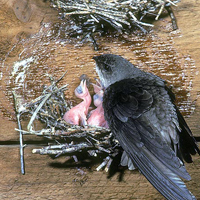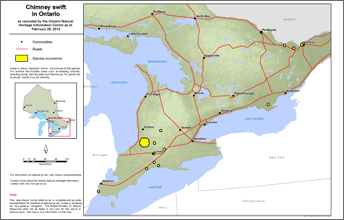Chimney swift
Scientific name: Chaetura pelagica


Cover photos credit: George K. Peck (left) and G. Armistead (right)
Status
Threatened
“Threatened” means the species lives in the wild in Ontario, is not endangered, but is likely to become endangered if steps are not taken to address factors threatening it.
Date added to the Species at Risk in Ontario List
September 10, 2009
Read the most recent assessment report (PDF)
What it looks like
The Chimney Swift is a relatively small bird, about 12 to 14 centimetres long, with a sooty brown, cigar-shaped body, long slender wings and a lighter throat. It can be distinguished by its telltale acrobatic and erratic flight pattern.
The Chimney Swift spends most of its time flying and even forages in the air, catching its prey (flying insects) in flight. Flocks can be heard making high-pitched chipping or twittering noises as they fly above the rooftops in urban areas.
Where it lives
Before European settlement Chimney Swifts mainly nested on cave walls and in hollow trees or tree cavities in old growth forests.
Today, they are more likely to be found in and around urban settlements where they nest and roost (rest or sleep) in chimneys and other manmade structures.
They also tend to stay close to water as this is where the flying insects they eat congregate.
Where it’s been found in Ontario
The Chimney Swift breeds in eastern North America, possibly as far north as southern Newfoundland. In Ontario, it is most widely distributed in the Carolinian zone in the south and southwest of the province, but has been detected throughout most of the province south of the 49th parallel. It winters in northwestern South America.
View a larger version of this map (PDF)
What threatens it
Historically, Chimney Swifts were likely sparse across their range and probably limited by suitable nesting sites (e.g., tree cavities and caves). Following European settlement, their numbers increased substantially as they began using chimneys as nest sites.
The primary causes of the current Chimney Swift population decline are unknown, but are likely related to declines in their prey, flying insects.
Chimney Swifts are one of many bird species that feed on flying insects and are declining. Chimney Swifts face the added pressure of habitat loss resulting from the modernization of chimneys (capped, round, metal flues) that prohibits the swifts from entering potential nest sites.
Action we are taking
Threatened Species and their general habitat are automatically protected.
Habitat protection
General habitat descriptions are technical, science-based documents that provide greater clarity on the area of habitat protected for a species.
Read the general habitat description (July 2, 2013)
Recovery strategy
A recovery strategy advises the ministry on ways to ensure healthy numbers of the species return to Ontario.
Read the executive summary and the full document (July 9, 2024).
What you can do
Report a sighting
Submit your observations of species at risk to the Natural Heritage Information Centre (NHIC), which is Ontario’s conservation data centre. Join the “(NHIC) Rare Species of Ontario” project in iNaturalist to make submitting your observations quick and easy.
Volunteer
Volunteer with your local nature club or provincial park to participate in surveys or stewardship work focused on species at risk.
Be a good steward
- Private land owners have a very important role to play in species recovery. If you find a Chimney swift nesting on your land, you may be eligible for stewardship programs that support the protection and recovery of species at risk and their habitats.
- There is a program geared to eligible farms registered under the Canada-Ontario Environmental Farm Plan to encourage greater protection and conservation of habitat for species at risk.
- As with all wildlife, don’t disturb or harass the birds or nesting sites. Be respectful and observe from a distance.
- Bird Canada is working to advance the understanding, appreciation and conservation of wild birds and their habitat in Ontario and elsewhere.
Report illegal activity
Report any illegal activity related to species at risk to
Quick facts
- Undertaking an activity near or affecting Chimney Swift? Your activity may qualify for streamlined approval and registration.
- These birds can congregate in flocks numbering in the thousands during migration and can be seen circling above traditional roosting sites such as, large old fashioned chimneys.
- It is not unusual for one or two adult Chimney Swifts to help parents with nesting duties such as incubation, brooding chicks and feeding nestling.
